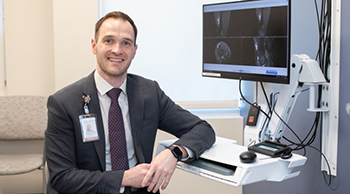
Popular Locations
- Outpatient Surgery - Bridgeport Hospital
- Park Avenue Medical Center
- Primary Care Center - Bridgeport Hospital

Published March 26, 2025

After a long afternoon on the soccer, baseball or lacrosse field, nobody wants to take a hard fall, tearing ligaments in their knees, dislocating their shoulders – or worse. For athletes of all skill levels, the next stop for medical care will largely depend on the injury itself.
Christopher Schneble, MD, an orthopedic surgeon at Bridgeport Hospital and assistant professor, Department of Orthopaedics and Rehabilitation at Yale School of Medicine (YSM), sees sports injuries year-round at his offices in Milford and Fairfield.
“My patients range widely in activity level, age and goals for their recovery,” Dr. Schneble said. “I work with each of them to discuss their treatment options that match their recovery ambitions, which can range from surgery to starting with a more conservative, non-operative approach. No matter the season, my role as a surgeon is to get them back into the activities they enjoy most."

Christopher Schneble, MD, an orthopedic surgeon at Bridgeport Hospital and assistant professor, Department of Orthopaedics and Rehabilitation at Yale School of Medicine, sees patients of all ages with sports injuries year-round.
In the spring, sports like soccer, lacrosse, gymnastics, and even pickleball, tend to result in a garden variety of injuries, such as muscle strains, ligamentous sprains or tears, and fractures.
“Contact sports like lacrosse can result in more traumatic injuries, causing acromioclavicular or AC joint injuries (i.e. a shoulder separation), broken collar bones, shoulder dislocations or acute ligament injuries, all of which may require more immediate orthopedic care,” Dr. Schneble said.
“If someone is injured or disabled in such a way that is preventing them from doing things that were once routine and simple, it might be more appropriate for a visit to the emergency department,” Dr. Schneble noted. “But when you’re talking about less disastrous-type injuries, whether it be nagging pain or instability, that’s what we’re here for: To diagnose and treat.”
While some sports injuries require surgery, many don’t. Overuse injuries, which are caused by repeated actions that apply pressure to certain muscle groups, joints or soft tissue, usually do not.
“Oftentimes, young people can tear a meniscus or ligaments in their knee that may require surgery, but it’s rare to see overuse-type injuries like tendonitis progress to surgical intervention,” Dr. Schneble said. “An overwhelming majority of patients do very well with some degree of activity modification and anti-inflammatory medications until symptoms resolve.
“Most minor injuries can be treated with rest, ice, compression and elevation – or RICE,” Dr. Schneble said. “Rest gives the body a chance to repair and recover. Ice can help reduce swelling; Compression helps provide support and stability while also reducing swelling; and elevation above the heart improves blood flow back to the heart.”
Physicial therapy may also be part of the treatment plan.
“If someone has a meaningful injury, it often results in some degree of acute motion loss. Physical therapy is helpful in these situations as it helps to restore normal motion,” Dr. Schneble said. “After restoring motion, regaining coordination and strengthening supporting muscles helps to offload joints or injured structures that may have been overworked and overstressed. Restoring a functional balance among muscles is an important concept not only for recovery but injury prevention as well.”
Athletes of all ages can regain maximum independence and functioning at the Ahlbin Rehabilitation Center, 3585 Main St., Stratford, where outpatient physical therapy services focus on the needs of each patient, including sports-related rehabilitation and orthopedic expertise.
“As the inflammation from the injury calms down, people start to become more functional and their muscles start to wake back up. Retraining and strengthening these muscles helps the body protect itself more — that’s really the benefit of what physical therapy does,” said Dr. Schneble, who often refers patients to the Ahlbin Center.
“It helps regain that coordination that was lost because an injury or pain was preventing proper movement patterns, like proper gait, or using an arm in a way that was routine prior to injury,” he said.
Whether a sports injury requires conservative treatment or a surgical approach, prevention remains the best medicine, no matter the season.
“Injuries tend to occur later in the day when people get tired, their muscles fatigue and they can no longer protect themselves as well. This is a fairly common occurrence,” Dr. Schneble said.
“If you are fatigued or exhausted, it may be in your best interest to sit out and rest prior to resuming play. Those are the moments that we are at the highest risk to sustain an injury,” he said. “Understanding when we are most vulnerable to sustain injuries and understanding why is impactful knowledge to have.”
Learn more about orthopedic services and.Ahlbin Rehabilitation Center and the services it provides at its outpatient locations.